Supervised by: Supervised by: Yash Salunkhe BSc (Hons). Yash is currently completing his MPhil in Economic Research at the University of Cambridge. He gained his BSc Econometrics and Mathematical Economics (EME) at the London School of Economics (LSE) in 2018. From 2018-19, Yash worked in Venture Capital in Pune, India, evaluating startups with a positive social impact. From 2019-2021, he worked in Wealth Management, helping large institutions invest their portfolios above $25 million. He has co-founded 2 charities: one focuses on improving outcomes in under-funded schools in India and the other was involved in varied community development projects.
Introduction
The European Commission’s Communication on Artificial Intelligence (European Commission, 2018) defines artificial intelligence as follows: ‘Artificial Intelligence (AI) refers to systems that display intelligent behavior by analyzing their environment and taking actions – with some degree of autonomy – to achieve specific goals. AI-based systems can be purely software-based, acting in the virtual world (e.g. voice assistants, image analysis software, search engines, speech and face recognition systems) or AI can be embedded in hardware devices (e.g. advanced robots, autonomous cars, drones or Internet of Things applications).’
AI directly stands for artificial intelligence; it is a form of technology which is made to mimic the problem-solving and decision-making abilities of the human mind (IBM, n.d.).
As we go on with our daily lives, Artificial Intelligence becomes more and more prominent. School children in the 21st century spend their days using browsers such as chatGPT or Snapchat My AI to help with homework and shortcuts. But our question stands as ‘what are the impacts of Artificial intelligence on the financial sector?’. Now, many could easily assume that AI has its positive and negative consequences in today’s society however when discussing the financial sector, the lines are blurred.
The financial sector is a complex and ever-changing industry. It is a specific area of the economy which consists of firms and institutions that provide financial services to commercial and retail customers. It deals with the exchange, management and flow of money and also encompasses a variety of services, activities and institutions that ease processes such as the allocation of capital, facilitating investments and financial transactions etc. Some key industries that make up the financial sector include banks, investment companies, stock exchanges, credit unions, real estate firms and other financial intermediaries. Many would agree that the financial sector is too imperative to be paired so closely with AI, however, from the perspective of many economists, there does seem to be an appeal to the idea as AI makes the sector more efficient, customer centric and accurate.
Today, our world is making thorough use of artificial intelligence within the 5th industrial era. The world we live in now is slowly transitioning from the standard of working people to advanced technology and machines, which many believe are becoming smarter than the creators of the machines themselves. It is not something that a person in the 5th industry can do even if they put as much effort as they did to create the AI itself, but it is a stage where people and artificial intelligence can unite and collaborate in harmony. Now, it has yet to be advanced to that level of AI and to that extent but, in today’s impatient society, many people have the inner urge to transfer the human way of doing day to day activities and jobs to the shoulders of artificial intelligence. AI is being used throughout the industrial and manufacturing sector and the idea of artificial intelligence is continuing to grow throughout the sector itself. The industrial sector itself includes stocks of companies that mainly produce capital goods of which are used within manufacturing, the extraction of resources and construction. Businesses in the industrial goods sector happen to make machinery alongside selling equipment and supplies that are used to produce goods (these goods are called capital goods and they promote economic growth) (Wohlner 2021).
Impacts of AI on the Financial Sector
There are most definitely concerns regarding AI however, ‘Artificial Intelligence opens up the world of financial services’ (McKendrick 2023). AI is known to be practically instantaneous in comparison to the momentum of employees so financial services seem to be taking on AI at a faster pace. This could be considered a positive or a negative aspect when it comes to moving forward. There are countless impacts of artificial intelligence upon the financial sector, including how AI would ultimately speed up every financial transaction from minutes to ‘split seconds’. Artificial intelligence is predicted and assumed to reduce and prevent fraud when it comes to the financial sector, which is something that would be considered a significantly advantageous adaptation within the sector itself as it would lead to preventing financial disasters such as the global financial crisis of 2008. This would ultimately ensure that costs for financial institutions are reduced on risk management and regulation as AI would securely take the reins on that part. Dr Lewis mentioned how Artificial Intelligence can “make appropriate, informed decisions about risk and capital allocation” which is particularly promising considering how artificial intelligence itself is nowhere close to full development (McKendrick 2023). There are still significant concerns when it comes to artificial intelligence, including how it is not even close to perfection, however developers are realizing that it may never be close to our human idea of perfection. Artificial intelligence could simultaneously be too risky to consider relying on for the financial sector especially if it is not yet at its full and content capacity. Alongside this, artificial intelligence could cause a significant increase in unemployment, which would be detrimental for the sanity of the economy and for large swathes of the population.
How is AI Already Being Used within the Financial Sector?
The financial sector is already becoming increasingly equipped with artificial intelligence and there are many examples of how this is true, including how banks are using AI and machinery to account for predicting consumer behavior to better understand their purchasing preferences and it allows financial institutions to accelerate and automate the more time-consuming tasks such as market research as well as identifying certain trends within data to make forecasting future performance more and more efficient (HPE 2023).
This graph demonstrates how the financial sector is gradually transforming and adapting to artificial intelligence more and more as time goes on (Regunath 2021).
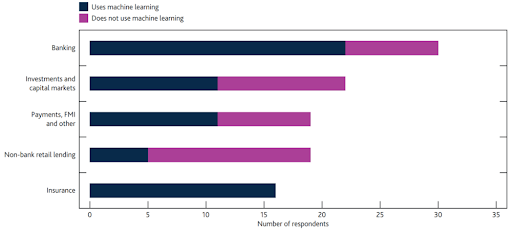
The graph implies that there is not a single area involved in the finance industry of which does not include the help and assistance of artificial intelligence; however sections such as ‘non-bank retail lending’ involves less use of machine learning than the various other sectors involved in the financial industry. AI is continuously used within credit decisions as well as providing a more efficient yet accurate assessment of any potential borrower which leads to increased decisions which are more data-backed and accurate (Bachinskiy 2019). Many top-tier financial industries such as High Radius, Lingxi, Numerai and many more all use artificial intelligence as they agree with the efficiency as well as the calculator accuracy of it. Let’s take Lingxi into account; this is a Beijing based startup which employs AI machine learning to calculate investments, debts and insurance deals. This futuristic outlook has allowed Lingxi to prosper in their goals as well as develop their company in a way that ultimately benefits their customers, providing them with efficient and reliable services (AIT Staff Writer 2023). The overall market value of artificial intelligence within the financial sector was estimated to be approximately $9.45 billion in the year 2021 and this value is expected to expand by 16.5% by 2030, demonstrating an effective change as we move into the future. The benefits and challenges we are already facing when it comes to AI will only continue to prosper, however economists and AI developers have confidence that the challenges will ultimately weaken and the benefits will be close to unmatchable buy any human intervention (Schroer 2023).
Ethical Implications of AI in the Financial Sector?
Ethics are moral principles that govern a person’s behavior or the conduct of an activity, providing opportunities for meaningful work supports positive outcomes for workers (Allan et al. 2019) and is ethically important as a basis for human wellbeing and flourishing (Bailey et al. 2019; Lysova et al. 2019). However, despite becoming an increasingly widespread feature of workplaces, there remains a poor understanding of how AI use will influence opportunities for relevant and important work. In the last five years, AI ethics has gone from being a purely academic issue to being a topic of political and public discussion. The increasing ubiquity of smartphones and the AI-driven applications that many of us now rely on every day and the fact that AI is increasingly impacting all sectors. There has been an astonishing number of national and worldwide efforts from NGOs, academic and industrial groups, professional organizations, governments, and the leisure industry, as well as the potential for an AI “arms race”.
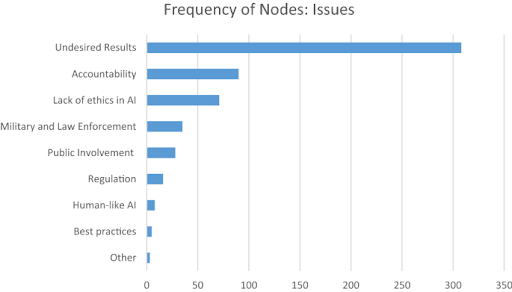
The increasing use of AI in the financial sector brings about various ethical implications. While AI offers various benefits such as improved efficiency, better customer experience etc, it also raises concerns regarding various issues such as data privacy, algorithm bias, transparency, accountability and potential job displacement.
Data Privacy: AI algorithms in the financial sector are often trained on large amounts of data, which can include personal information such as social media posts, medical records, financial transactions etc. The collection and processing of large amounts of sensitive financial data by AI systems can increase the risk of data breaches and cyber attacks. This can result in substantial losses for both consumers and financial institutions. To mitigate this risk, financial institutions must stick to vigorous data protection measures and act in accordance with relevant privacy laws and regulations, such as the General Data Protection Regulation (GDPR) in the European Union, to protect individuals’ sensitive information, as ensuring the security and privacy of this data is very essential.
Algorithm bias: Algorithms are mathematical formulas that are used to make decisions. In the financial sector, algorithms are often used to make decisions about investing, lending and insurance. AI algorithms can accidentally perpetuate biases present in the data they are trained on. This could lead to unfair treatment of customers. For example, an algorithm used to make lending decisions could be biased against people of different races or genders. This could also impact other processes of the financial sector such as credit scoring and data approvals. Thus, financial institutions must be vigilant in identifying and mitigating algorithm biases to ensure fair and unbiased outcomes for all customers using techniques such as diverse data collection, regular data audits, human oversight etc
Transparency and Explainability: One of the biggest challenges with AI is that it is very complex and tough to interpret. This makes it difficult to hold AI systems accountable for their actions. It becomes crucial for financial institutions to ensure they explain to customers how the AI systems work and how they are used to make decisions. This will help the institutions build trust with their customers, because a lack of transparency and explainability can lead to discriminatory and unfair practices and could result in legal and ethical implications.
Accountability and Liability: Financial institutions should develop policies and procedures to ensure that they are held accountable for any decisions made by AI, because, as AI systems become more common, questions arise regarding its accountability and liability. Establishing clear frameworks is necessary to address potential issues and protect customer rights.
Potential Job Displacement: Here, the integration of AI may lead to potential job displacements as certain tasks may become automated. Financial institutions need to ensure that employees are re-oriented or re-assigned to new roles. Ethical considerations should also focus on reducing the negative impact on employees while fully utilizing the benefits of AI.
Other impacts on society will be the Labour Market and its workforce, inequality and exploitation of workers, and concentration of power amongst elites. Nemitz (2018) writes that it would be ‘naive’ to ignore that AI will concentrate power in the hands of a few digital internet giants, as ‘the reality of how [most societies] use the Internet and what the Internet delivers to them is shaped by a few mega corporations…the development of AI is dominated exactly by these mega corporations and their dependent ecosystems’.
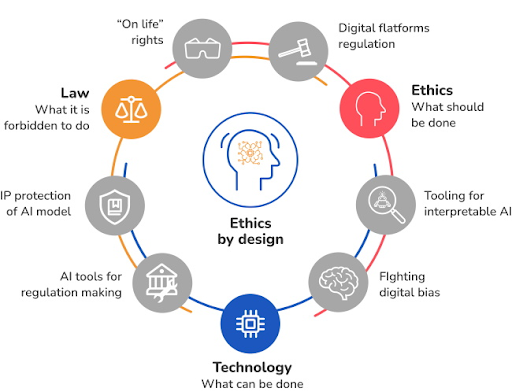
Fig.: Orient
Future Implications of AI on the Financial Sector
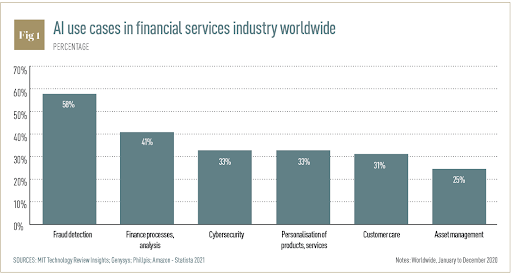
AI has already had a remarkable impact on the financial sector, and it is expected to continue shaping the industry in the future. It boosts our capacity to make use of the substantial amounts of data produced by our regular business operations. We may use it to find trends, anticipate the future, build rules, automate procedures, and communicate more effectively. Due to the data-intensive and technologically dependent nature of the financial services sector, all AI capabilities are extremely significant for suppliers of such services. Therefore, it doesn’t come as a surprise that AI will be at the top of the financial sector. Some potential future implications of AI may include enhanced customer experience, risk assessments and fraud detection systems, investment strategies, cybersecurity and data privacy etc. In order to store, process, and analyze massive volumes of data, as well as to increase scalability and lower costs, banks are increasingly relying on cloud-based solutions. They could possibly learn more about consumer behavior and market trends as a result. Also, as chatbots are becoming more pertinent in the financial sector, they might also be used to improve customer service and automate repetitive tasks. ChatGPT is a great example of a Natural Language Processing (NLP) model. It is trained to generate human-like texts when given an input. Similarly, ChatGPT and other similar models can be used in a variety of different ways to improve customer service, automate processes and gain insights from data. According to some reports by Maruti Techlab, it is estimated that chatbots can save banks up to 30% on customer service costs.
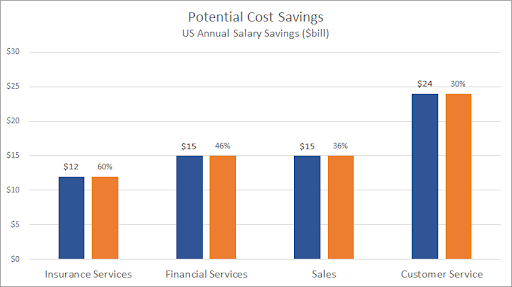
The figure above suggests that potential savings of $23 billion can be achieved in the U.S. because chatbots have the potential to automate 30% more of the tasks done by today’s contact center staff (Maruti Techlab 2017). Also, AI can be used to improve fraud detection in banks. For example, machine learning algorithms can analyze transaction data to identify patterns of duplicitous activities, and also use behavioral biometrics, such as fingerprint or facial recognition, to detect such suspicious activities.
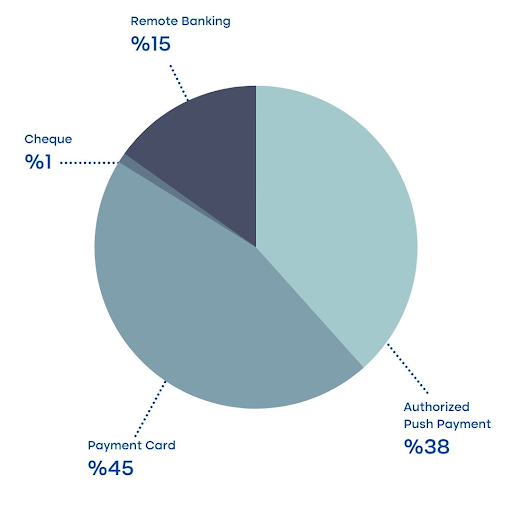
Real Time AI Fraud detection in banking
AI can also be used to predict analytics in the financial sector and identify potential risks, optimize lending and investment decisions and improve customer targeting. This would ensure improved accuracy in the system, Real time insights, personalized recommendations, forecasting and planning etc. This would moreover help improve overall business performance. For example, Dataiku, founded in 2013, claims to have created methods for machine learning that are used to analyze raw data in different forms, with the objective of creating predictive data models (such as historical transactions for a certain product or customer transcripts from sales interactions in retail). The business asserts that their software may aid businesses in forecasting and identifying patterns in unstructured data, resulting in increased productivity and decreased operating expenses. Financial organizations may thus improve decision-making processes and get helpful and practical insights by utilizing AI.
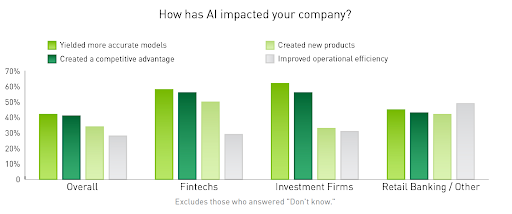
Fig: NVIDIA Blog
Impacts of AI on How the Manufacturing Sector Works
The industrial industry is known to be acquainted with carbon emissions and detrimental environmental impacts so artificial intelligence happens to lower this significantly, resulting in lower carbon emissions which is most definitely helpful in today’s ‘heating’ world. This fact ensures that many manufacturing industries are taking on artificial intelligence with vigor and with efficiency. Further, it is known that artificial intelligence is strengthening climate predictions and helping to enable smarter and strategic decision-making specifically for decarbonising industries spanning from building industries to transportation as they continue to allocate carbon free renewable energy (Ekin 2019). The purpose of AI is to reshape the future and to assist humanity with efficiency however, due to the continuously arising field of climate change and global warming, there was always going to be a concern that AI will make this worse but fortunately engineers realize that they are in control of the situation so why not make artificial intelligence environmentally sustainable. According to the OECD, the impact of global megatrends (including the population, resources, and the environment) on our society over the next ten to fifteen years is predicted, and the direction of our response to science and technology innovation policies is sought. Officials expect competition in knowledge, talent, and resources to intensify while increasing the influence of scientific and technological activities due to the growth of our emerging economies, the actions of multinational companies, and the global value chain.
AI implementation in manufacturing brings significant time and cost savings. By incorporating AI into factory data production bases, AI systems can independently detect and address potential issues before they arise. This proactive approach eliminates the need for manual troubleshooting and reduces downtime. Moreover, AI-driven maintenance processes are cost-effective and enable precise quantity monitoring, ensuring optimal resource utilization. AI’s capabilities extend beyond human limitations, such as in demand forecasting, where AI outperforms human efforts by avoiding common errors. Another area where AI excels is in managing inputs, which are fundamental to manufacturing processes. AI systems can optimize ingredient usage, reducing material waste significantly compared to human operations. This efficiency contributes to cost reduction and aligns with sustainable practices by minimizing resource consumption and promoting environmental responsibility. The continuous advancements in AI technology offer even more significant potential for streamlining manufacturing operations, improving productivity, and driving overall operational excellence.
AI manufacturing is crucial in enhancing quality control and defect detection processes. By utilizing advanced defect detection systems, manufacturers can effectively monitor and manage the quality of objects, particularly when the adhesive strength of a product reaches a certain threshold. Visual data analysis is employed to detect defects through system images or video trends, eliminating the need for a manual inspection that would typically take several hours. By leveraging AI technology, manufacturers can significantly reduce the time and costs associated with quality control while ensuring consistent product quality. This allows companies to allocate resources to other critical tasks, improving overall operational efficiency. Furthermore, implementing AI-driven defect detection systems helps ensure that only high-quality products reach the market, increasing customer satisfaction and attention. Delivering superior products enhances brand reputation and fosters long-term customer loyalty. The continuous advancements in AI and visual data analysis techniques hold great potential for further improving quality control processes in manufacturing, paving the way for more efficient and reliable production systems.
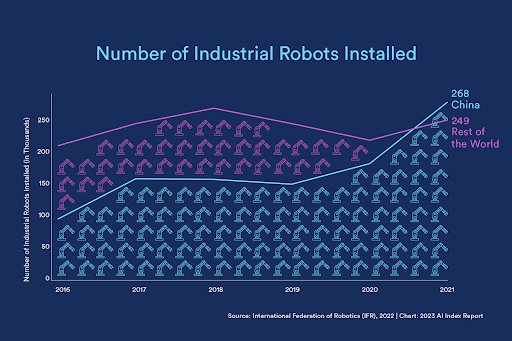
How Is AI Used in the Manufacturing Sector Today?
AI manufacturing saves our time and money. If AI is applied to the data production base in manufacturing industries, it will find it independently and without the help of humanity. Not only this, artificial intelligence happens to provide a level of efficiency and accuracy that no human can match, but many do struggle to understand exactly how this happens. Not only is the maintenance cost for artificial intelligence particularly low, but it is made clear through research that AI is like nothing humanity has ever manufactured and engineered before.
Manufacturers use artificial intelligence to analyze data as well as predict breakdowns and accidents which commonly occur without the use of AI. AI is so popular and in high demand amongst manufacturers today as it manages to increase the productive efficiency of the economy which stimulates economic growth, which can be shown on the graph below
(“Economic Growth” 2020). This curve imitates the production possibility frontier showing the growth of the economy due to stimulants such as AI, however this outward shift only occurs under the assumption that we are working at full capacity causing economic growth as shown.
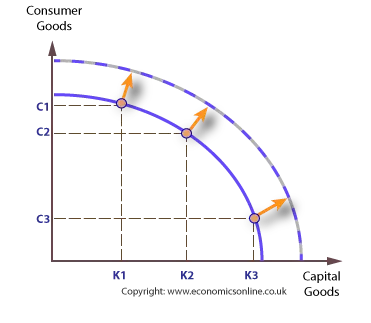
Manufacturers today are hastily turning to artificial intelligence in order to lower their own costs and maintenance for production lines, which also allows them to gain the funds to continue to improve their use of AI due to lowered maintenance costs in the long run, which overall lowers the costs of production within the manufacturing sector itself.
AI manufacturing also saves quality control and defect detection. The defect detection system is used to simply detect and manage the quality of a certain structure or of certain objects. You can use artificial intelligence to prevent quality issues such as risks as well as the general quality of certain objects. Using AI will ultimately reduce spending as well as costs of production as previously discussed, allowing employees in certain industries to focus and develop other aspects of the company, in order to increase productive potential and ultimately produce higher quality products more efficiently. For example, if only high-quality products are delivered to the market, customers’ attention and satisfaction can be significantly increased after purchasing products which will begin to increase the demand for certain products and allow firms and industries to grow their revenue and profit gains. A key goal for firms is to increase output and increase profits to as great an extent as possible, which can overall be done under the influence of artificial intelligence.
Concluding AI and Its Potential Impacts on the Labor Market of the Financial & Manufacturing
Although artificial intelligence has its challenges as well as its benefits, financial industries believe that the positives seem to outweigh its negative impacts, as AI has seemingly stimulated increased efficiency within the financial sector, emulating the goal of increased economic growth alongside increased profits for certain companies. It seems that looking to the future, artificial intelligence will become increasingly prominent within the financial industry as there is a growing appeal to such advanced technology. There are, of course, concerns that artificial intelligence will never be developed enough to rely on completely, however the efficiency and accuracy of the technology is seemingly more appealing towards financial industries today. AI is being used across the globe and there are many financial industries which are already making compelling use of the abilities that AI possesses, however there is always the uncertainty that increased usage of AI will ultimately cause job losses for many, which will overall increase the rates of unemployment. This is clearly a cause for concern, however it is a concern that industries will most likely choose to ignore. Manufacturing industries do understand that relying on AI to do every job available is most definitely a step in the wrong direction as, although it is as developed and reliable as it can be, industries cannot afford to allow technology to define them as ultimately employees will lose their jobs which will cause devastating impacts for the economy as we know it. Unemployment is a factor which has significant and lasting impacts on the economy and the countries with great unemployment have less purchasing power as consumers are unlikely to spend money due to lack of confidence in their futures. Unemployment also lowers GDP growth rates significantly, emulating and supporting the reasoning for both the financial and manufacturing sectors resisting full reliance on AI. There is also the continuing argument that AI does not have the capacity to do many of the jobs humans can do themselves, so how far can we actually go with AI?
References
AIT Staff Writer. 2023. “Top 10 AI Companies that Serve Banking and Finance Industry.” AiThority. https://aithority.com/technology/top-10-ai-companies-that-serve-banking-and-finance-industry/.
Bachinskiy, Arthur. 2019. “The Growing Impact of AI in Financial Services: Six Examples.” Towards Data Science. https://towardsdatascience.com/the-growing-impact-of-ai-in-financial-services-six-examples-da386c0301b2.
Bankins, and Formosa. 2021. “The Ethical Implications of Artificial Intelligence (AI) For Meaningful Work.” J Bus Ethics, February 11, 2021. https://link.springer.com/article/10.1007/s10551-023-05339-7/#citeas.
Bartneck, Christoph, Christoph Lütge, Alan Wagner, and Sean Welsh. 2020. “Psychological Aspects of AI.” In An Introduction to Ethics in Robotics and AI, 1. N.p.: Springer International Publishing. http://dx.doi.org/10.1109/SAIS55783.2022.9833054.
Bird, Eleanor. 2020. “The ethics of artificial intelligence: Issues and initiatives | Think Tank.” European Parliament. https://www.europarl.europa.eu/thinktank/en/document/EPRS_STU(2020)634452.
“Economic Growth.” 2020. Economics Online. https://www.economicsonline.co.uk/competitive_markets/economic_growth.html/.
Ekin, Annette. 2019. “AI can help us fight climate change. But it has an energy problem, too.” European Commission. https://ec.europa.eu/research-and-innovation/en/horizon-magazine/ai-can-help-us-fight-climate-change-it-has-energy-problem-too.
“How AI is Shaping the Future of Financial Services.” 2022. Deloitte. https://www2.deloitte.com/nz/en/blog/financial-services/2022/ai-in-financial-services.html.
HPE. 2023. “What is AI in Finance?” Hewlett Packard Enterprise (HPE). https://www.hpe.com/us/en/what-is/ai-in-finance.html.
IBM. n.d. “Types of artificial intelligence-weak AI vs. strong AI.” IBM. Accessed June, 2023. https://www.ibm.com/topics/artificial-intelligence#:~:text=Artificial%20intelligence%20leverages%2.
Kenton, Will. 2021. “Financial Sector: Definition, Examples, Importance to Economy.” Investopedia. https://www.investopedia.com/terms/f/financial_sector.asp.
McKendrick, Joe. 2023. “Artificial Intelligence Opens Up The World Of Financial Services.” Forbes. https://www.forbes.com/sites/joemckendrick/2023/02/24/artificial-intelligence-opens-up-the-world-of-financial-services/.
Nguyen, Linh. 2022. “What Is Ethical AI & Why Is It Essential for Business.” Orient Software. https://www.orientsoftware.com/blog/ethics-in-ai/.
Regunath, Gavita. 2021. “6 Ways AI is Transforming the Finance Industry — Advancing Analytics.” Advancing Analytics. https://www.advancinganalytics.co.uk/blog/2021/8/26/mo482xc608yon5wplj0iobz7cjmtg.
Schroer, Alyssa. 2023. “29 Examples of AI in Finance.” built in. https://builtin.com/artificial-intelligence/ai-finance-banking-applications-companies.
Wohlner, Roger. 2021. “Industrial Goods Sector: How It Works and How To Track It” Investopedia. https://www.investopedia.com/terms/i/industrial-goods-sector.asp#:~:text=The%20industrial%20goods%20sector%20includes,than%20sold%20directly%20to%20consumers.
2023 State of AI in 14 Charts https://hai.stanford.edu/news/2023-state-ai-14-charts.




